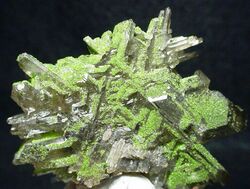Chemistry:Duftite
| Duftite | |
|---|---|
 Duftite from Tsumeb Mine, Tsumeb, Otjikoto Region, Namibia | |
| General | |
| Category | Arsenate minerals |
| Formula (repeating unit) | PbCuAsO4(OH) |
| Strunz classification | 8.BH.35 |
| Dana classification | 41.5.1.4 |
| Crystal system | Orthorhombic |
| Crystal class | Disphenoidal (222) H-M symbol: (2 2 2) |
| Space group | P212121 |
| Unit cell | a = 7.768(1), b = 9.211(1) c = 5.999(1) [Å]; Z = 4 |
| Identification | |
| Formula mass | 426.67 g/mol |
| Color | Green, olive green or grey green. Generally zoned due to compositional variations. |
| Crystal habit | Tiny crystals elongated along [001] with curved and rough faces, aggregated into crusts. Crystals may be pseudo-octahedral. |
| Cleavage | Indistinct |
| Fracture | Uneven to conchoidal |
| Mohs scale hardness | 4.5 |
| |re|er}} | Vitreous on fracture surfaces and dull on crystal faces |
| Streak | Pale green or white |
| Diaphaneity | Crystals are transparent to translucent |
| Specific gravity | 6.4 (measured), 6.60 (calculated) |
| Optical properties | Biaxial (-), faint apple-green color (transmitted light) |
| Refractive index | nα = 2.03–2.04, nβ = 2.06–2.08, nγ = 2.08–2.10 |
| Birefringence | δ = 0.06 |
| 2V angle | Large |
| Dispersion | r > v, perceptible |
| Solubility | Readily soluble in acids[1] |
| Other characteristics | Decrepitates on heating. Not radioactive. |
| References | [2][3][4] |
Duftite is a relatively common arsenate mineral with the formula CuPb(AsO4)(OH), related to conichalcite. It is green and often forms botryoidal aggregates. It is a member of the adelite-descloizite Group, Conichalcite-Duftite Series. Duftite and conichalcite specimens from Tsumeb are commonly zoned in color and composition. Microprobe analyses and X-ray powder-diffraction studies indicate extensive substitution of Zn for Cu, and Ca for Pb in the duftite structure. This indicates a solid solution among conichalcite, CaCu(AsO4 )(OH), austinite, CaZn(AsO4)(OH) and duftite PbCu(AsO4)(OH), all of them belonging to the adelite group of arsenates.[6] It was named after Mining Councilor G Duft, Director of the Otavi Mine and Railroad Company, Tsumeb, Namibia.[1] The type locality is the Tsumeb Mine, Tsumeb, Otjikoto Region, Namibia.
Structure
The structure[7] is composed of chains of edge-sharing CuO6 distorted octahedra parallel to the c axis. The chains are linked by AsO4 tetrahedra and Pb atoms.
Environment
Duftite is an uncommon product of weathered sulfide ore deposits. It is associated with azurite at the type locality,[1] and with bayldonite, segnitite, agardite and gartrellite at the Central Cobar Mines, New South Wales, Australia, where some pseudomorphs of duftite after mimetite have also found.[8] It occurs in association with olivenite, mottramite, azurite, malachite, wulfenite and calcite in the Tsumeb, Namibia deposit. It occurs with bayldonite, beudantite, mimetite and cerussite in the Cap Garonne mine, France .[4]
Distribution
Reported from Argentina, Australia, Austria, Chile, the Czech Republic, France, Germany, Greece, Italy, Japan, Mexico, Namibia, Poland, Portugal, Russia, South Africa, Spain, Switzerland, the UK, the US and Zimbabwe.[3]
References
- ↑ 1.0 1.1 1.2 "New mineral names". American Mineralogist 6: 140–141. 1921. http://www.minsocam.org/ammin/AM6/AM6_140.pdf.
- ↑ Duftite. Webmineral.com. Retrieved on 2011-10-10.
- ↑ 3.0 3.1 Duftite. Mindat.org
- ↑ 4.0 4.1 Duftite. (PDF) Handbook of Mineralogy
- ↑ Warr, L.N. (2021). "IMA–CNMNC approved mineral symbols". Mineralogical Magazine 85 (3): 291–320. doi:10.1180/mgm.2021.43. Bibcode: 2021MinM...85..291W.
- ↑ Jambor, J L, Owens, D R and Dutrizac, J E (1980). "Solid solution in the adelite group of arsenates". Canadian Mineralogist 18: 191–195. http://rruff.info/uploads/CM18_191.pdf.
- ↑ Kharisun; Max R. Taylor; D. J. M. Bevan; Allan Pring (1998). "The crystal chemistry of duftite, PbCuAsO4(OH) and the beta-duftite problem". Mineralogical Magazine 62 (1): 121–130. doi:10.1180/002646198547413. Bibcode: 1998MinM...62..121K. http://rruff.geo.arizona.edu/doclib/mm/vol62/MM62_121.pdf.
- ↑ Australian Journal of Mineralogy 11 (2): 79.
Bibliography
- Palache, P.; Berman H.; Frondel, C. (1960). "Dana's System of Mineralogy, Volume II: Halides, Nitrates, Borates, Carbonates, Sulfates, Phosphates, Arsenates, Tungstates, Molybdates, Etc. (Seventh Edition)" John Wiley and Sons, Inc., New York, pp. 810-811.
 |


